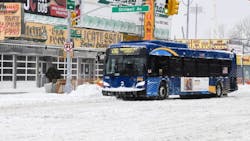New York area transit agencies, Partnership for New York City launch sixth annual Transit Tech Lab competition
The Metropolitan Transportation Authority (MTA), the Port Authority of New York and New Jersey, New Jersey Transit, the New York City Department of Transportation (NYC DOT) and the Partnership for New York City have launched the sixth annual Transit Tech Lab competition, which this year is calling for tech-driven approaches to support the agencies’ objectives in customer experience, resiliency and curb management.
Applications for the Customer Experience, Resilience and Curb Activity challenges are now open until Feb. 28 and are available here.
Representatives from each participating agency will evaluate applications based on the technology’s impact and the applicant’s product, team and overall value proposition. Finalists will advance to conduct a proof-of-concept during an eight-week period. The companies demonstrating the most compelling technologies that align with the agencies' objectives have the opportunity to secure a year-long pilot. To date, 21 companies have been selected to participate in year-long pilots, conducting deeper tests to demonstrate the real-world value of their technology to agency partners.
Customer Experience Challenge
NYC regional transit agencies are looking at ways to better communicate service changes, reduce delays and augment safety and cleanliness initiatives.
Technologies may include:
- Tools, including gamification, to encourage paid ridership.
- Improved methods for customer-facing communication to convey schedule diversions, delays, alternative transit options and onboard train announcements.
- Tools to improve processing of customer feedback, including processes to manage internal response and more timely communications back to customers.
- Predictive analytical tools to estimate average outage time for common delays.
- Tools to detect, prioritize and maintain safety and cleanliness in stations and vehicles.
- Improved tools to facilitate paratransit operations, including improving the processing and evaluation of paper-based eligibility requests and improving communication of issues relevant to paratransit customers.
- Tools to help commuter rail lines understand passenger flows and predict customer travel patterns flows to better optimize schedules.
- Tools to optimize work in the right of way via improving planning, coordinating outages, managing equipment and prioritizing flagging resources.
- Augmented reality/virtual reality technologies to digitize safety, operations, maintenance and construction training.
Resilience Challenge
The regional transit agencies are looking at ways to build a more resilient and adaptive transit system.
Technologies may include:
- Technologies to predict which transit assets across the system may be at risk from extreme weather and other climate change-related events.
- Tools to help mitigate climate-related vulnerabilities across the system.
- Tools to enhance stormwater resilience of the system, including tools to prevent water intrusion and expedite water removal.
- Technologies to augment manual surveying and inspection work on aging infrastructure (especially right of way and retaining walls).
- Electrification tools to enable more dynamic charging and electric vehicle fleet management.
- Tools to optimize battery-electric bus charging operations.
- Tools to power resiliency at bus depots including the use of microgrids and renewable battery charging.
- “Green” construction materials.
NYC DOT’s Curb Activity Challenge
NYC DOT is looking to maximize the city’s curb space to serve the multiple and varied needs of New Yorkers.
Technologies may include:
- Tools to support efficient and orderly use of curb space for non-car uses, such as cargo bikes, micromobility devices.
- Tools to enable use of curb space for recreation or commerce (e.g. street seats).
- Tools that support using curb space to improve pedestrian safety (such as new ways to protect daylighted intersections).
- Tools to prevent unauthorized use of curb space (e.g. retractable bollards).
- Tools to more effectively communicate allowable curb uses (new markings or signage types, but which take into account maintenance issues).
- Tools to monitor curb usage of various vehicle types (trucks, buses, bikes, etc.).
The Curb Activity challenge aims to help NYC DOT implement the Curb Management Action Plan and enable better decision making and regulations. NYC DOT is taking a “blank slate” approach and calling for scalable technology to provide data that helps NYC DOT better understand curb inventory: What regulations, restrictions and features are where and/or curb activity: Who is using the curb in what way.
“A thriving public transit system means a thriving New York and that’s why we are so excited to help put innovative technologies to work to improve the rider experience. We are looking forward to yet another year of impactful collaboration between transit agencies and tech innovators, who will be working together once again to help ensure our public transportation can quickly adapt and respond to 21st century challenges,” said Stacey Matlen, vice president of innovation at the Partnership for New York City.
“The Transit Tech Lab continues to be a significant incubator of innovative solutions for the most pressing transportation challenges the MTA and other regional transportation agencies face. We look forward to seeing the next set of proposed technologies that will strengthen the MTA’s ongoing resiliency efforts and further the authority’s mission to improve the customer experience for transit riders,” said Jessica Mathew, senior advisor for special projects at MTA.
Since 2018, the Transit Tech Lab has fielded more than 750 applicants, tested 51 technologies and facilitated eight commercial engagements.
